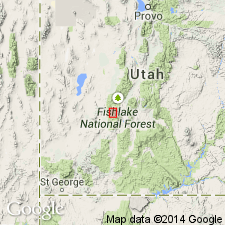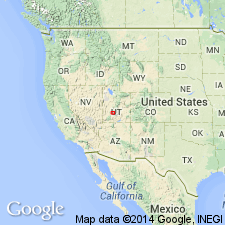
- Usage in publication:
-
- Red Hills Tuff Member*
- Modifications:
-
- Named
- AAPG geologic province:
-
- Great Basin province
Summary:
Unit is named the Red Hills Tuff Member of the Mount Belknap Volcanics. Is a simple cooling unit of densely welded ash-flow tuff derived from the Red Hills caldera. Consists of red and gray ash-flow tuff. Thickness is 300 m. Overlies the Joe Lott Tuff Member or intervening unnamed crystal-rich or upper red tuff members; underlies the Gray Hills Rhyolite Member; units are part of the outflow facies of the Mount Belknap Volcanics. Age is Miocene. (B1564)
Source: GNU records (USGS DDS-6; Menlo GNULEX).

- Usage in publication:
-
- Red Hills Tuff Member*
- Modifications:
-
- Named
- Dominant lithology:
-
- Tuff
- AAPG geologic province:
-
- Wasatch uplift
Summary:
Named as a member of the Mount Belknap Volcanics for Red Hills, about 4.8 km north 10 degrees east of center of Marysvale (the type area), Piute Co, UT on the Wasatch uplift. Is a densely welded ash-flow tuff derived an out-flow facies from the Red Hills caldera. May be as much as 300 m thick. Contains 7.6 percent phenocrysts of alkali feldspar, quartz, plagioclase, Fe-Ti oxides, and traces of apatite and zircon. Is younger than Joe Lott Tuff Member (rank revised) and older than the Gray Hills Rhyolite Member and the upper tuff member, all of the Mount Belknap. Assigned a Miocene age.
Source: GNU records (USGS DDS-6; Denver GNULEX).
For more information, please contact Nancy Stamm, Geologic Names Committee Secretary.
Asterisk (*) indicates published by U.S. Geological Survey authors.
"No current usage" (†) implies that a name has been abandoned or has fallen into disuse. Former usage and, if known, replacement name given in parentheses ( ).
Slash (/) indicates name conflicts with nomenclatural guidelines (CSN, 1933; ACSN, 1961, 1970; NACSN, 1983, 2005, 2021). May be explained within brackets ([ ]).

